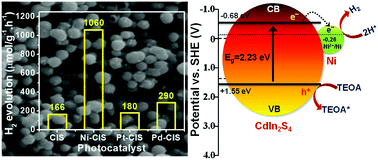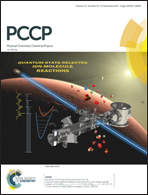Ni supported CdIn2S4 spongy-like spheres: a noble metal free high-performance sunlight driven photocatalyst for hydrogen production†
Abstract
Nickel supported CdIn2S4 (Ni-CIS) spongy-like spheres have been developed using alcoholysis followed by a sulfidation process. The formation of nanocrystalline-single phase CdIn2S4 was confirmed using X-ray diffraction studies. Electron microscopy images showed that the spongy-like spheres are composed of CdIn2S4 nanoparticles with average sizes of around 25 nm. X-ray photoelectron spectra indicated the presence of elements with their respective stable oxidation states that led to the formation of single phase CdIn2S4 with enhanced structural integrity and chemical composition. The absorption spectra indicated the visible light activity of the material and the band gap energy is deduced to be 2.23 eV. The photocatalytic efficiency of the synthesized Ni-CIS in relation to its ability to produce hydrogen under solar light irradiation is estimated to be 1060 μmol g−1 h−1, which is around 5.5 and 3.6 fold higher than that of Pt-CIS (180 μmol g−1 h−1) and Pd-CIS (290 μmol g−1 h−1), respectively, as obtained in this study. Accordingly, the mechanism of the observed efficiency of the Ni-CIS nanoparticles is also proposed. The recyclability test showed consistent hydrogen evolution efficiency over 3 cycles (9 h), which essentially revealed the excellent photo- and chemical-stability of the photocatalyst. The strategy to utilize non-noble metals such as Ni, rather than noble-metals, as a co-catalyst opens up a new possibility to develop low cost and high-performance sunlight-driven photocatalysts as achieved in this study.



 Please wait while we load your content...
Please wait while we load your content...